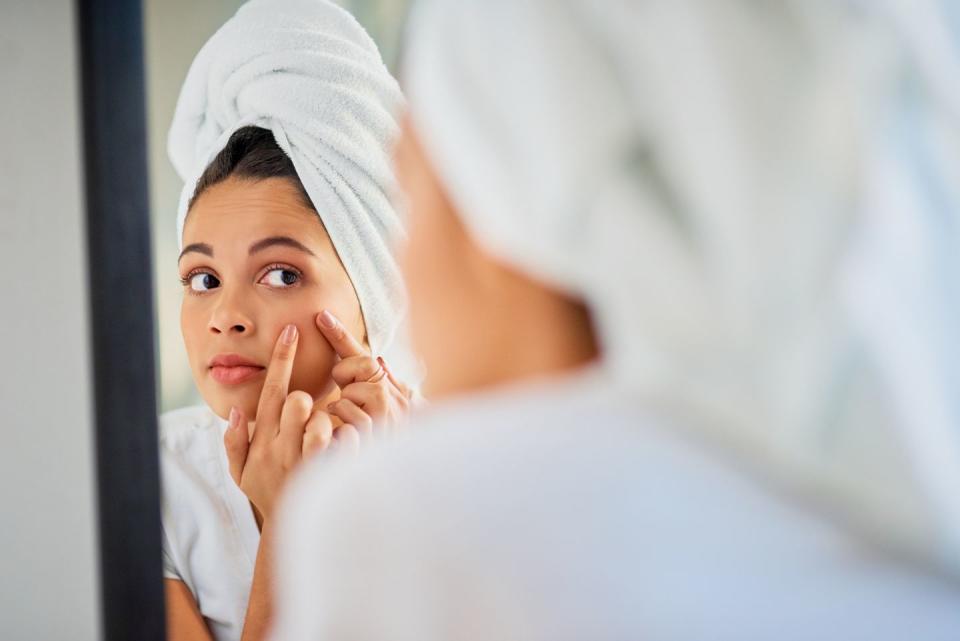Squalane: what is it and what are the benefits for skin and hair?

If you’re partial to studying the ingredients list of your skincare products, you might have noticed squalane is popping up all over the place. In fact, you can even buy squalane oil as a standalone beauty product.
But what is it? And what are the alleged skin (and hair) benefits?
We spoke with Dr Rekha Tailor, former GP and Medical Director of Health & Aesthetics, to find out more.
What is squalane?
‘Squalane is a hydrocarbon derived by the hydrogenation of squalene,’ explains Dr Tailor. ‘Squalene (with an ‘e’) is a lipid (or a fat), which is produced naturally by your skin cells.’
But if squalene is your body’s natural moisturiser – a component of the sebum produced to keep your skin clean and healthy – why might you need a top-up?
‘The amount of squalene your body produces declines with age,’ reveals Dr Tailor. ‘Squalene itself isn’t stable enough for use in skincare products, because they’re intended to be kept on the shelves for a long period of time. Therefore, squalane is derived from squalene and is the more stable form of this molecule. It’s also colourless and odourless – a great hydrator that is easily absorbed into the skin.’
Skin benefits of squalane
The biggest benefit of squalane is purported to be its hydrating properties. However, there are additional benefits, too.
‘‘Squalane is an effective hydrator,’ says Dr Tailor. ‘It mimics your skin’s natural oils, meaning it’s a good emollient. It’s also a natural antioxidant and can protect skin from carcinogens.’
Indeed, a 2012 review entitled Biological Importance and Applications of Squalene and Squalane, published in Advances in Food & Nutrition Research, reveals that several studies exhibited results that show both squalane and squalene have anticancer, antioxidant, detoxifier, emollient and skin hydrating properties.

Hair benefits of squalane
If you think squalane is just for use on your skin, think again: it apparently has benefits for your hair, too.
‘Your hair has its own natural oils,’ says Dr Tailor. ‘But factors such as age, weather and heat damage can result in it drying out. Squalane can help to moisturise hair and increase shine. It also helps to prevent breakage, as well as protecting hair from future damage.’
However, Dr Tailor points out it is vital not to neglect other areas, such as nutrition, which also play a key role in hair (and skin) health.
‘It’s important to remember that factors such as diet and lifestyle can have a superior impact on your skin and hair,’ she says.
Can you use squalane if you have oily skin?
If you have a dry complexion, squalane sounds like a great option, to help keep your skin looking and feeling refreshed and hydrated. But what about if you have oily skin, or are prone to acne or breakouts?
Actually, squalane oil is a good alternative to other heavier, greasier oils. Because it is lightweight and noncomedogenic, it does not block pores (and blocked pores are the cause of spots).
‘Squalane is suitable for all skin times, from oily to dry to acne-prone,’ says Dr Tailor, ‘as it absorbs into the skin easily.’
However, if you have oily, acne-prone skin, adding additional oil to your skin is probably not necessary.

Squalane and eczema
If it’s such a good skin hydrator, could it be used as an eczema treatment?
‘There is some evidence that squalane can be used as an eczema treatment, because of the fact it’s full of natural, skin-balancing properties,’ says Dr Tailor. ‘It’s an incredibly gentle, natural emollient and has also been shown to have anti-inflammatory properties. However, it’s important to speak to your GP if you are worried about your condition.’
How to use squalane oil
If you’ve decided to introduce squalane oil into your skincare routine, it’s important to apply it correctly, to ensure you gain maximum benefits.
‘Cleanse the skin properly first and then massage in a few drops of squalane oil,’ advises Dr Tailor.
Cleansing prior to application is key because, while squalane itself won’t clog your pores, other substances, including your natural oils and bacteria, can. Cleansing will also allow the squalane oil to penetrate your skin properly.
‘You can then apply your usual moisturiser and SPF on top,’ says Dr Tailor.
Risks of using squalane
Because it’s so lightweight and easily absorbed, in theory squalane should be fine for everybody to use. However, it’s important to start slowly.
‘As with all skincare products, there’s a risk of allergy or irritation, so it’s always important to try the product on a small area first as a patch test and observe how the skin reacts to it, before applying more over a larger area,’ advises Dr Tailor. ‘If irritation or allergy occurs, then stop using it.’
Signs of an allergic reaction to a skincare product can include:
itching
redness
the area feeling hot
inflammation/swelling
bumps appearing on the skin
Is squalane ethical?
These days, most squalane is made from an ethical, plant-based source. However, traditionally squalene was harvested from sharks’ livers, so when shopping for squalane oil, always check its origin, to ensure it is environmentally friendly and cruelty free.
‘Squalane is derived by the hydrogenation of squalene, which is found naturally in the skin lipid barriers of plants, animals and humans,’ says Dr Tailor. ‘Traditionally, squalene was derived from the livers of sharks. However, for ethical reasons most skincare companies have shifted away from this and now get squalene that is derived from plants, such as olives and rice bran. It can also be derived from other plant oils, including sugar cane and wheat germ. By checking that your skincare is vegan, you can make sure it doesn’t contain squalene from sharks.’
Last updated: 27-05-2020
You Might Also Like

